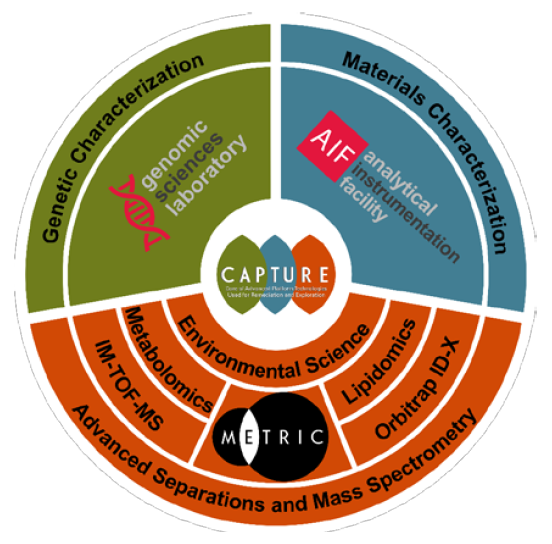Core of Advanced Platform Technologies Used for Remediation and Exploration (CAPTURE)
Director: Erin Baker
Mass Spectrometrist: Jeff Enders
Submit your analytical requests here.
Responding to newly discovered environmental contaminants requires novel analytical approaches.
The overall objective of CAPTURE is to provide expertise, state-of-the-art instrumentation and novel analytical approaches to address a broad range of scientific questions presented across the NC State Superfund Research (SRP) Center. CAPTURE will provide analytical capabilities to the four projects in the NC State Superfund Research Center through the development and application of tools to enable rapid, comprehensive assessment of PFAS presence. This will be accomplished using platform technologies with novel analytical platforms and methods providing significantly improved limits-of-detection and novel algorithms to focus on fluorinated species.
To achieve this objective, CAPTURE has three specific aims:

Specific Aim 1: Utilize state-of-the-art MS instrumentation and workflows to advance identification and quantification of PFAS in human populations, environmental samples, and model systems.
CAPTURE will use a multi-pronged approach to provide high-throughput detection and quantification of PFAS at physiologically relevant concentrations. Multiple SPE chemistries, including fluoro-selective SPE columns will be used to enrich for distinct chemical classes, yielding additional information about the underlying molecules. The combination of SPE phases and multiple analysis platforms (Orbitrap ID-X and IM-TOF-MS) will allow for comprehensive capture of PFAS subclasses that would otherwise be missed by a single, biased analytical approach.

Specific Aim 2: Employ combinatorial, untargeted omics technologies to advance the understanding of PFAS mechanisms of action.
Historically, environmental monitoring has been limited to single chemicals or small sets of known chemicals. Calls for an extensive expansion of exposure assessment to include currently unknown compounds have made this an important public health goal. In this aim, homogenized spleens and B cells isolated from mice exposed to different PFAS at different concentrations will be evaluated using metabolomics, lipidomics, and transcriptomics to determine which pathway(s) are perturbed by exposures. Parallel metabolomic/lipidomic and transcriptomic experiments will be executed using human innate immune cell lines (macrophage and neutrophil) exposed to different PFAS at different concentrations and durations. Metabolomic and transcriptomic data will provide information about which metabolites and transcriptional events are influenced by PFAS exposure and how they relate to altered immune cell function. Patterns of change will help build a mechanistic picture of metabolic patterns altered by PFAS exposure.

Specific Aim 3: Implement advanced electron microscopy and spectroscopy techniques to directly observe adsorbates on activated carbon.
Granular activated carbon (GAC) effectiveness for PFAS removal from water strongly depends on GAC characteristics, PFAS properties, and the type/concentration of dissolved organic matter (DOM) in the PFAS-contaminated water. To gain mechanistic understanding of PFAS penetration into the GAC particles, we will use advanced AIF instrumentation to directly observe intraparticle distribution of the adsorbed PFAS (by mapping F) and polystyrene sulfonate (PSS, by mapping S). The resulting information will allow calibration of a shell adsorption model for the Remediation Project.

CAPTURE is comprised of the Genomic Sciences Laboratory (GSL), the Analytical Instrumentation Facility (AIF), and the Molecular Education, Technology and Research Innovation Center (METRIC) at NC State, which have over $25M in modern instrumentation and are operated by more than 20 PhD-level, highly qualified personnel. These capabilities provide CAPTURE with the ability to explore the diversity of scientific questions with a broad range of measurements including RNA-seq, materials characterization, and mass spectrometry analyses for the known and unknown per- and polyfluoroalkyl substances (PFAS). New methods and reagents will result from this work which will enable and inform the entire scientific community about PFAS in the environment. Additionally, CAPTURE will enhance interactions among Center projects and other cores, increasing their impact by ensuring synchronization of exposure measurements and increasing their value in decision-making, translation, and community engagement.

CAPTURE will provide essential analytical services to all four Center projects while meeting the NIEHS Superfund Research Program Mandate 1: development of advanced techniques for the detection, assessment, and evaluation of the effect of hazardous substances on human health. This Center proposes to develop a platform comprising novel methods for the identification of new PFAS; evaluation of human health risks associated with these exposures; and planning for the health effects of exposure on communities. Raw data generated from CAPTURE components will flow through the Data Management and Analysis Core (DMAC; see DMAC for details); through integration with the Project PIs and Administrative and Community Engagement Cores, data will be translated and communicated to community and government stakeholders.
CAPTURE will generate an abundance of resources and data to be shared with the scientific community. These will include detailed experimental methods and protocols, synthesized reagents via corporate partnerships, and RAW data files from the numerous instrumental analyses. Together, CAPTURE’s state-of-the art targeted and untargeted analyses will be used to provide the essential support need by the Projects and other Cores. This Core will also serve as an organizational and unifying feature, ensuring cross-program collaboration and coordination of exposure estimates and exposure science across the Center.
The application of these integrated and state-of-the-art technologies will help the Center define the role of PFAS in the environment and its affect on human health.
